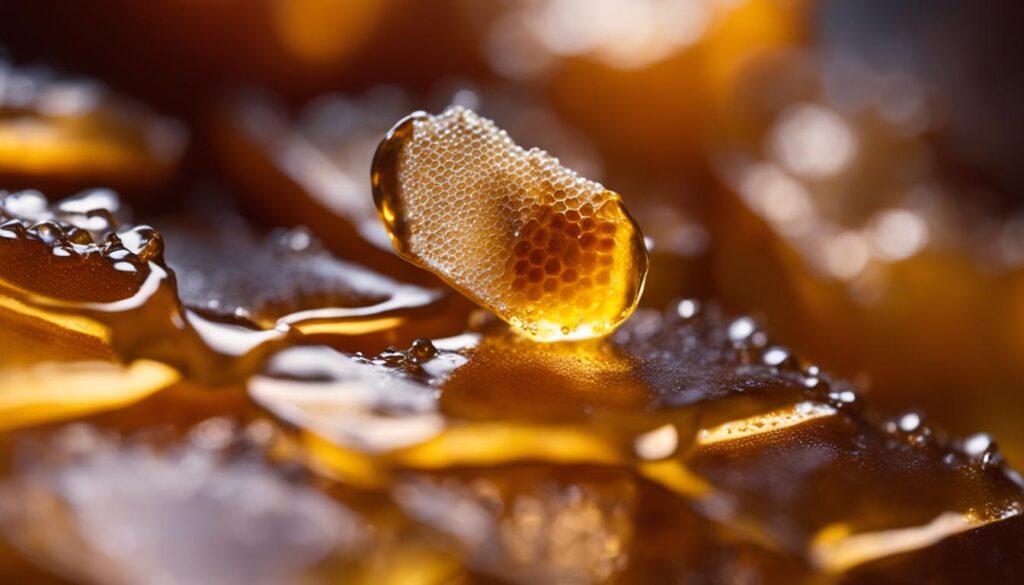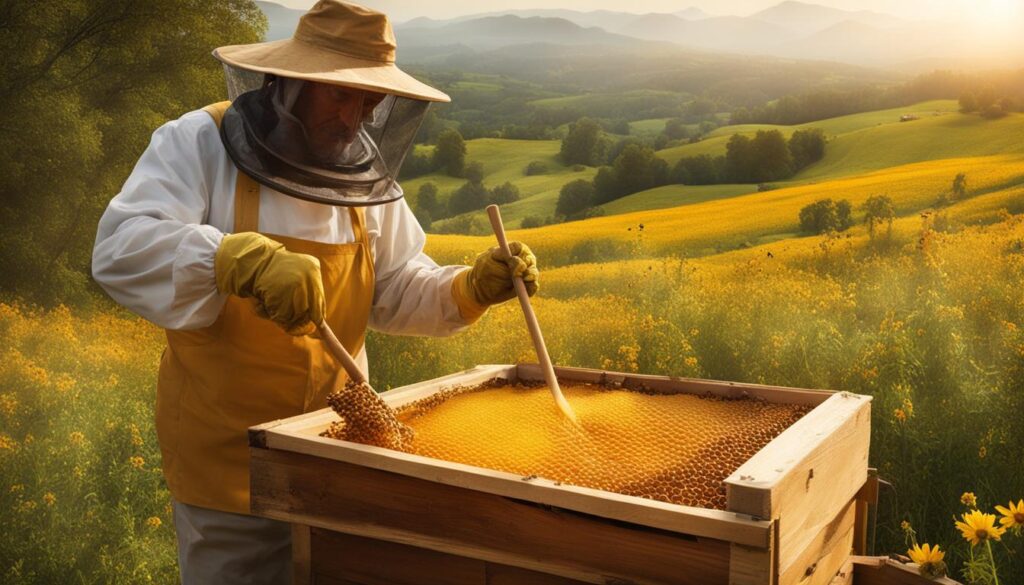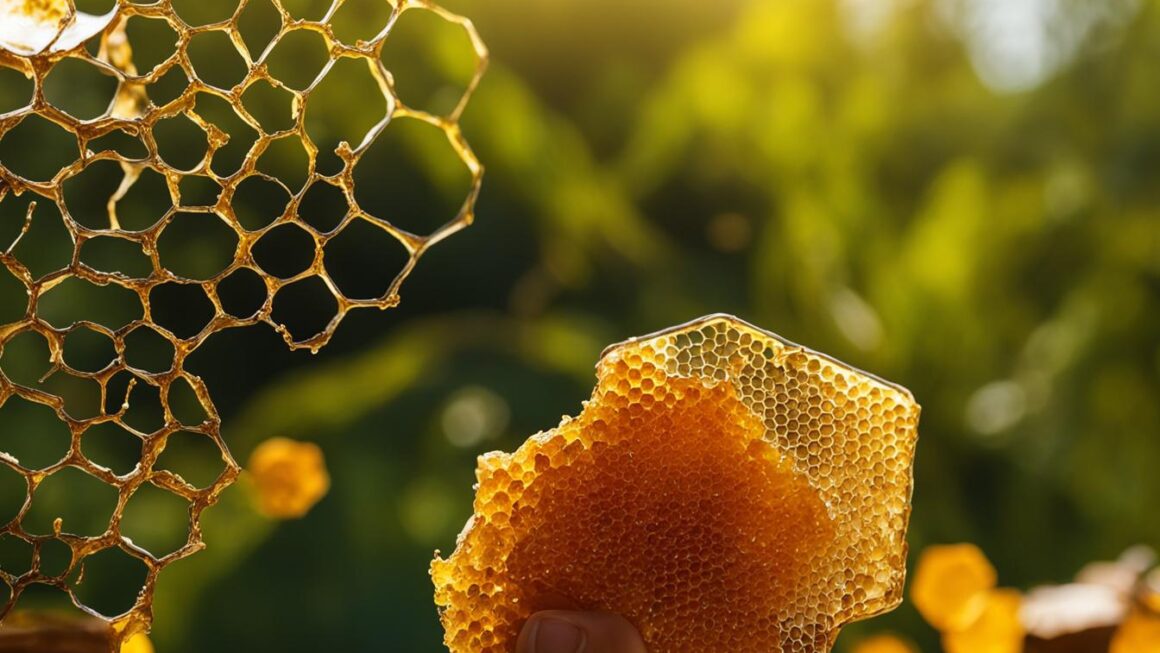Experience the delightful and unique sensation of eating honeycomb. Not only does it offer a delicious flavor, but it also provides numerous health benefits. Raw honeycomb is packed with vitamins, minerals, antioxidants, and natural enzymes, making it a nutritious and one-of-a-kind snack.
Key Takeaways:
- Eating honeycomb offers a distinct flavor and texture.
- Raw honeycomb contains essential vitamins, minerals, and antioxidants.
- Honeycomb provides natural enzymes that support overall health.
- Enjoy honeycomb as a nutritious and enjoyable snack.
- Explore the world of honeycomb and discover its unique benefits.
Can You Eat Honeycomb? Yes, You Can!
Eating honeycomb is a delightful experience that not only satisfies your taste buds but also offers several health benefits. But you might be wondering, can you actually eat honeycomb? The answer is yes! Honeycomb is perfectly safe and enjoyable to eat. Made from raw honey in its most natural form, it consists of a wax shell that melts away when consumed. The flavor of raw honeycomb is distinct from processed honey, with its earthy, floral, or fruity notes. So, if you’ve been curious about trying honeycomb, go ahead and give it a try!
In addition to its unique taste, honeycomb also contains beneficial components that contribute to its health properties. Bee pollen, propolis, and royal jelly found in honeycomb have immune-boosting properties, which can support your overall well-being. These natural compounds are known for their ability to strengthen the immune system and protect against diseases. So, not only does honeycomb offer a delicious treat, but it also provides a boost to your immunity!
How to Eat Honeycomb?
When it comes to enjoying honeycomb, there are various ways you can savor its flavors and reap its benefits. You can simply eat small chunks of honeycomb on its own, treating it like a candy. Alternatively, you can spread honeycomb on toast or incorporate it into your favorite recipes as a sweetener and garnish.
For a unique taste experience, consider pairing honeycomb with cheese, fruits, or nuts. You can also add it to hot tea or oatmeal to enhance their flavors. The versatility of honeycomb allows you to get creative with your culinary experiments and discover new combinations that tantalize your taste buds.
So, next time you come across honeycomb, don’t hesitate to give it a try. Experience the pleasure of indulging in this natural delicacy and enjoy the numerous health benefits it has to offer!
Benefits of Honeycomb
Honeycomb offers a variety of benefits that make it a valuable addition to your diet. As a natural product, honeycomb is rich in essential vitamins, minerals, antioxidants, and bioactive compounds. These nutrients provide holistic nutrition, supporting overall health and well-being.
One of the key benefits of honeycomb is its role in digestion. Due to its prebiotic properties, honeycomb acts as a food source for beneficial gut bacteria, promoting a healthy gut microbiome. This can improve digestion and nutrient absorption, leading to better overall digestive health.
Honeycomb also shows promise in alleviating allergies. Some studies suggest that consuming honeycomb can help reduce allergy symptoms by exposing the body to small amounts of pollen. Over time, this exposure may help desensitize the immune system and reduce the severity of allergic reactions.
| Benefits of Honeycomb | Summary |
|---|---|
| Rich in essential nutrients | Honeycomb is packed with vitamins, minerals, antioxidants, and bioactive compounds that support overall health. |
| Aids in digestion | The prebiotic properties of honeycomb promote a healthy gut microbiome, improving digestion and nutrient absorption. |
| Potential allergy relief | Consuming honeycomb may help alleviate allergies by gradually desensitizing the immune system to pollen. |
With its range of nutritional benefits and potential positive effects on digestion and allergies, honeycomb is a valuable addition to a healthy diet. Incorporating honeycomb into your meals and snacks can provide a unique and delicious boost to your overall well-being.
How is Honeycomb Made?
Honeycomb is a marvelously intricate creation by honey bees. It is made through a fascinating process that showcases the remarkable abilities of these tiny creatures. The bees start by secreting beeswax from special glands on their bodies. This wax is then chewed and molded into hexagonal cells, which serve as storage vessels for honey and the queen bee’s eggs. The bees carefully construct these cells, ensuring maximum efficiency and space utilization.
Within each cell, bees deposit nectar collected from flowers. Through the process of regurgitation and evaporation, the bees transform the nectar into honey. As the honey matures, it thickens and becomes denser, filling the cells and sealing them with a wax cap. This ensures the honey remains protected and preserved.
Aside from honey, honeycomb also contains other beneficial substances produced by bees. These include pollen, propolis, and royal jelly, each with their own unique properties and benefits. Pollen provides essential nutrients, propolis has antimicrobial properties, and royal jelly is rich in proteins and vitamins. The combination of these substances contributes to the nutritional value, digestive benefits, and potential allergen-fighting properties of honeycomb.
The creation of honeycomb is a testament to the ingenuity and cooperation of these incredible insects. From the secretion of beeswax to the construction of hexagonal cells, every step in the process showcases the hive’s remarkable organization and efficiency. The end result is a natural marvel that not only provides us with delicious honey but also offers a range of health benefits.
Where Can I Buy Honeycomb?
To savor the delicious taste and reap the numerous benefits of honeycomb, you can find it at various locations. Whether you prefer the convenience of online shopping or the charm of local markets, honeycomb is readily available for purchase. Here are some options to consider:
- Honey Retail Stores: Many specialized honey stores offer a wide selection of honeycomb. These stores often source their products directly from local beekeepers, ensuring freshness and quality.
- Local Markets and Farmers’ Markets: Visiting your local markets is an excellent way to support local beekeepers and enjoy fresh honeycomb. Beekeepers often set up stalls at these markets, allowing you to purchase their honeycomb directly.
- Online Retailers: Numerous online retailers provide the convenience of ordering honeycomb from the comfort of your home. Make sure to choose reputable sellers that offer high-quality honeycomb sourced from reliable beekeepers.
When buying honeycomb, it’s important to consider its source. Look for honeycomb sourced from responsible beekeepers who prioritize the well-being of their bees and maintain sustainable practices. This ensures that you are getting honeycomb that is both delicious and ethically produced.
So, whether you are passionate about supporting local businesses or enjoy the ease of online shopping, purchasing honeycomb is a simple endeavor. With its unique flavor and undeniable health benefits, honeycomb is a worthwhile addition to your pantry.
How to Eat Honeycomb
Eating honeycomb is a delightful experience that can be enjoyed in various ways. Here are some suggestions on how to savor this unique treat:
Straight from the Hive
One simple way to enjoy honeycomb is by eating small chunks of it on its own. The wax shell melts in your mouth, releasing the rich and sweet flavors of the raw honey. Each bite offers a burst of floral, fruity, or earthy notes, depending on the source of the honeycomb. It’s a truly indulgent experience that allows you to appreciate the natural goodness of this delicious treat.
Spread on Toast or Cracker
Honeycomb can also be spread on your favorite toasted bread or cracker. The natural sweetness of the honeycomb adds a delightful twist to your breakfast or snack. You can even pair it with butter or cream cheese to complement the flavors. The creamy texture of the cheese combined with the crunchy texture of the honeycomb creates a harmonious contrast that will tantalize your taste buds.
Incorporated into Recipes
Honeycomb can be used as an ingredient in various recipes, adding a unique flavor and texture. It can be crushed and sprinkled over desserts like ice cream or yogurt for an extra touch of sweetness and crunch. You can also incorporate honeycomb into baked goods such as cakes, muffins, and cookies, infusing them with its distinct taste. Additionally, honeycomb can be a beautiful garnish for charcuterie boards, paired with cheese, fruits, and nuts for a visually appealing and delicious spread.

Experiment with different recipes and combinations to find your favorite way of enjoying honeycomb. Whether you prefer it on its own, as a sweet spread, or as an ingredient in your culinary creations, honeycomb is sure to elevate your taste experience with its unique flavors and beneficial properties.
How to Store Honeycomb
Properly storing honeycomb is crucial to maintain its freshness and preserve its unique flavor. Here are some tips on how to store honeycomb:
Short-Term Storage:
For short-term storage, keep the honeycomb in an airtight container or wrap it tightly in plastic wrap to prevent exposure to air and moisture. Store it at room temperature in a cool, dry place away from direct sunlight. This will help ensure that the honeycomb retains its texture and flavor for a few weeks.
Long-Term Storage:
If you want to store honeycomb for a longer period, it is best to freeze it. Freezing helps to preserve the honeycomb’s quality and prevent any spoilage. Place the honeycomb in an airtight container or zip-top freezer bag, making sure to remove as much air as possible. Label the container with the date to keep track of its freshness. When you’re ready to use the honeycomb, let it thaw in the refrigerator overnight. Thawing it slowly helps maintain its texture and flavor.
Preventing Crystallization:
Over time, honeycomb may begin to crystallize. This is a natural process and does not affect its quality. In fact, some people prefer the texture of crystallized honeycomb. However, if you prefer a softer consistency, you can gently warm the honeycomb in a water bath or microwave. Be cautious not to overheat it, as excessive heat can cause the wax to melt. Once warmed, the honeycomb will return to its smooth, liquid state.
| Storage Method | Temperature | Duration |
|---|---|---|
| Airtight Container at Room Temperature | Cool, Dry Place (Away from Sunlight) | A Few Weeks |
| Freezer | Below 0°C (32°F) | Several Months |
Remember, honeycomb is a natural food product and may vary in texture and flavor over time. It is always best to consume it within its recommended storage duration for the best taste and quality.
The Old-Fashioned Way of Enjoying Honeycomb
Delving into the history of honeycomb reveals a traditional treat that has been enjoyed for centuries. Before modern methods of processing honey, people indulged in the pure goodness of honeycomb straight from the hive. This old-fashioned way of savoring honeycomb not only provided a natural and unprocessed experience but also allowed individuals to reap the nutritional benefits of raw honey.
In ancient times, honeycomb was treasured for its sweetness and perceived medicinal properties. It was highly valued and used in various culinary and medicinal practices across different cultures. The wax cells of the honeycomb served as storage vessels for honey, while also providing a home for the queen bee’s eggs. This natural packaging preserved the integrity of the honey and protected it from external elements.
| Benefits of Old-Fashioned Honeycomb | Nutritional Value | Immune-Boosting Properties |
|---|---|---|
| • Authentic honey flavor | • Vitamins and minerals | • Natural enzymes and antioxidants |
| • Unique texture | • Bee pollen and propolis | • Potential allergy relief |
| • Versatile culinary ingredient | • Digestive benefits | • Traditional holistic remedy |
Honeycomb provides a delightful taste experience, with its authentic honey flavor and unique texture. Its nutritional value, including vitamins, minerals, natural enzymes, and antioxidants, contributes to overall well-being. The presence of bee pollen and propolis enhances its immune-boosting properties, while the potential allergy relief it offers adds to its appeal. Honeycomb also serves as a versatile culinary ingredient and holds a special place as a traditional holistic remedy.
With the current resurgence of interest in natural and wholesome foods, honeycomb has regained popularity and can now be found in various stores and farmers’ markets. The appreciation for the old-fashioned way of enjoying honeycomb is a testament to its timeless appeal and the recognition of its exceptional nutritional value.

Honeycomb: A Nutritional Powerhouse
Honeycomb is not only a delicious treat but also a powerhouse of nutrition. Packed with vitamins, minerals, and antioxidants, it offers a range of benefits for your health. Here are some of the key reasons why incorporating raw honeycomb into your diet can have a positive impact:
Benefits of Honeycomb
- Rich in Antioxidants: Honeycomb contains powerful antioxidants that help protect your body against harmful free radicals and reduce inflammation.
- Boosts Immune System: The natural enzymes and bioactive compounds in honeycomb may strengthen your immune system and support overall wellness.
- Supports Digestion: Honeycomb’s prebiotic properties promote a healthy gut microbiome and aid in digestion, improving nutrient absorption.
- Potential Allergy Relief: Some studies suggest that consuming local honeycomb may reduce allergy symptoms by exposing your body to small amounts of allergens.
- Nutrient-Rich Superfood: Honeycomb is a nutrient-dense food, containing vitamins, minerals, and essential amino acids that contribute to your daily nutritional needs.
With its natural goodness, honeycomb can be a valuable addition to any diet. Now that we understand its benefits, let’s explore how to incorporate honeycomb into your daily routine.
How to Enjoy Honeycomb
There are various ways to savor the unique flavors and textures of honeycomb:
- Eat it as a Snack: Enjoy small chunks of honeycomb on its own, like a sweet and chewy treat. It’s a delightful alternative to traditional candies.
- Spread it on Toast: Swap your usual toast condiments with a layer of honeycomb. The combination of natural sweetness and crunch will elevate your breakfast or snack.
- Use it in Recipes: Honeycomb can be used as a natural sweetener and flavorful garnish in recipes. From desserts to savory dishes, it adds a touch of elegance and unique taste.
- Pair it with Cheese and Fruits: Create a charcuterie board with honeycomb, cheese, fruits, and nuts. The contrast of flavors and textures will impress your guests.
- Add it to Beverages: Drop a piece of honeycomb in hot tea or stir it into a bowl of oatmeal for a delectable twist.
These suggestions are just the beginning. Experiment and explore the versatility of honeycomb in your culinary adventures, and enjoy its health benefits along the way.
Conclusion
Eating honeycomb is a truly unique and delightful experience that offers a myriad of benefits. Not only does it provide a delicious taste sensation, but it also delivers a wealth of nutritional value. The vitamins, minerals, antioxidants, and natural enzymes found in raw honeycomb make it a nutritious and wholesome snack.
From supporting overall health and well-being to boosting the immune system, honeycomb is a natural and wholesome choice. It aids in digestion, promotes a healthy gut microbiome, and may even alleviate allergies. Incorporating honeycomb into your diet can have a positive impact on your health.
Whether enjoyed on its own or used in various recipes, honeycomb is a versatile and satisfying addition to any meal. With its distinct flavor and texture, honeycomb can elevate your culinary creations and add a touch of uniqueness to your dishes. So why not explore the world of honeycomb and discover the joys it has to offer?
FAQ
Is it safe to eat honeycomb?
Yes, eating honeycomb is perfectly safe and enjoyable.
What does raw honeycomb taste like?
Raw honeycomb has a distinct flavor, described as earthy, floral, or fruity.
What are the benefits of honeycomb?
Honeycomb is rich in vitamins, minerals, enzymes, antioxidants, and bioactive compounds, providing holistic nutrition and aiding in digestion. It may also help alleviate allergies and improve the immune response.
How is honeycomb made?
Honeycomb is made by honey bees using beeswax, which they secrete from glands. The bees create hexagonal cells that store honey and provide a home for the queen bee’s eggs.
Where can I buy honeycomb?
Honeycomb can be purchased in honey retail stores, local markets, or online. It is important to choose honeycomb sourced from reputable beekeepers for optimal quality and freshness.
How can I eat honeycomb?
Honeycomb can be enjoyed on its own in small chunks, spread on toast, used as a sweetener in recipes, or paired with cheese, fruits, and nuts. It can also be added to hot tea or oatmeal for a unique taste experience.
How should I store honeycomb?
Honeycomb should be stored in airtight containers. For short-term storage, a plastic bag can be used. For long-term storage, it is best to keep honeycomb in the freezer and thaw before use.
What is the history of honeycomb?
Eating honeycomb straight from the hive has been a traditional treat enjoyed for centuries.
What are the health benefits of raw honeycomb?
Raw honeycomb provides essential vitamins, minerals, antioxidants, and antibacterial properties that support overall well-being, strengthen the immune system, aid digestion, and may alleviate allergies.




